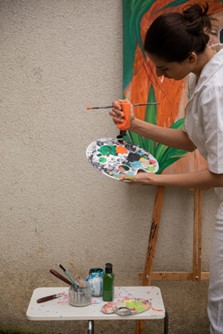Art has long been recognized as a powerful tool for social change, capable of inspiring dialogue, challenging perceptions, and mobilizing communities to address pressing issues. In recent years, there has been a growing recognition of the role that young people can play in harnessing their creative talents to advocate for positive change and address social, cultural, and environmental challenges in their communities. Below, Mickey Oudit of Washington discusses the concept of art for social change and the ways in which youth can leverage their artistic abilities to drive meaningful impact and promote social justice.
Why Art for Social Change?
Art for social change, also known as socially engaged art or community-based art, refers to artistic practices that aim to address social issues, raise awareness, and catalyze action for positive change. Unlike traditional forms of art that may prioritize aesthetics or individual expression, art for social change is rooted in a commitment to social justice, equity, and collective action.
This form of art often involves collaboration between artists, community members, activists, and organizations, with the goal of creating art that reflects and responds to the lived experiences, concerns, and aspirations of diverse communities. It encompasses a wide range of artistic mediums, including visual art, performance art, music, film, literature, and digital media, all of which can be powerful tools for engaging audiences and inspiring social transformation.
Empowering Youth
Young people are uniquely positioned to harness the power of art due to their creativity, energy, and passion for peace and unity. By providing young people with opportunities to explore and express their ideas, experiences, and perspectives through artistic mediums, we can empower them to become agents of change in their communities.
Youth-led art projects and initiatives allow young individuals to address issues that are important to them, whether it’s climate change, racial injustice, mental health, or individual rights. Through art-making, young people can amplify their voices, share their stories, and advocate for positive social change in ways that resonate with their peers and broader audiences.

Addressing Community Issues
Art for social change provides a platform for young people to address a wide range of community issues and advocate for solutions that reflect their values and priorities. From organizing public art installations and murals to staging theatrical performances and spoken word poetry events, young artists can raise awareness about social issues, foster empathy and understanding, and inspire action among community members.
For example, youth-led projects have been instrumental in raising awareness about environmental conservation and sustainability, promoting mental health and well-being, challenging stereotypes and discrimination, and advocating for social justice and human rights. Through collaborative processes, young people can engage with diverse stakeholders, build solidarity, and mobilize collective action to create positive change in their communities.
Building Skills and Resilience
Additionally, it not only promotes social awareness and activism but also helps young people develop a wide range of skills that are valuable for personal and professional growth. Through artistic expression, young individuals can enhance their creativity, critical thinking, problem-solving, communication, and collaboration skills, all of which are essential for success in today’s complex and interconnected world.
Moreover, it can serve as a form of self-expression, healing, and empowerment for young people who may be facing adversity or marginalization in their lives. By providing a creative outlet for self-reflection, self-discovery, and self-advocacy, art for social change can foster resilience, self-confidence, and a sense of agency among young artists, enabling them to overcome challenges and thrive in the face of adversity.
Amplifying Youth Voices
Creativity can also amplify the voices and perspectives of young people, who are often marginalized or overlooked in decision-making processes that affect their lives. By providing platforms for youth-led art projects, organizations, schools, and communities can elevate the voices of young artists, empower them to express themselves authentically, and advocate for issues that matter to them.
Youth-led art initiatives also create opportunities for intergenerational dialogue, collaboration, and mentorship, as young artists connect with experienced practitioners, activists, and community leaders who can provide guidance, support, and mentorship. By bridging generational divides and fostering mutual respect and understanding, art for social change strengthens community bonds and promotes collective action for a more just and equitable society.
Conclusion
Art for social change empowers young people to become catalysts for positive change in their communities by harnessing their creative talents, amplifying their voices, and advocating for issues that matter to them. Through collaborative art-making processes, young artists can address community issues, raise awareness, foster empathy, and inspire action for social justice and equity. By supporting youth-led art initiatives and providing opportunities for artistic expression and engagement, we can cultivate a new generation of socially conscious artists, activists, and leaders who are committed to building a more just, inclusive, and compassionate world.
